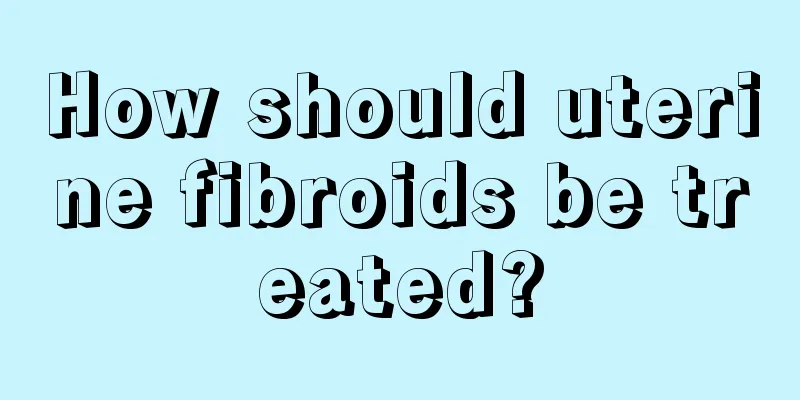How should uterine fibroids be treated?

|
The reason why a female organ is called the uterus is because it is the normal place for the fetus. Therefore, the uterus is very, very important to women. In daily life, you must not do things that hurt the uterus, and be careful not to have too intense sexual life, otherwise the uterus will easily be damaged by the male's reproductive organs. Uterine fibroids are relatively common in life, so how should uterine fibroids be treated? Uterine fibroids are the most common benign tumors in the female reproductive organs and one of the most common tumors in the human body. They are also called fibroids and uterine fibroids. Since uterine fibroids are mainly formed by the proliferation of uterine smooth muscle cells, with a small amount of fibrous connective tissue existing as a supporting tissue, it is more accurate to call them uterine leiomyomas. Referred to as uterine fibroids. treat 1. Follow-up observation If the patient has no obvious symptoms and no signs of malignancy, regular follow-up observation can be performed. 2. Medication (1) Gonadotropin-releasing hormone agonists (GnRH-a) Currently, the commonly used GnRH-a in clinical practice include leuprorelin, goserelin, and triptorelin. GnRH-a should not be used continuously for a long time. It is only used for pretreatment before surgery, generally for 3 to 6 months, to avoid causing severe menopausal symptoms caused by low estrogen. A small dose of estrogen can also be supplemented at the same time to counteract this side effect. (2) Mifepristone is a progesterone antagonist that has been clinically tried in recent years to treat uterine fibroids. It can reduce the size of fibroids, but the fibroids often grow again after discontinuation of the drug. (3) Danazol Used for preoperative medication or treatment of uterine fibroids that are not suitable for surgery. Uterine fibroids may grow larger after medication is stopped. Danazol can cause liver damage and androgen-induced side effects (weight gain, acne, hoarse voice, etc.). (4) Tamoxifen can inhibit the growth of fibroids. However, long-term use may cause enlargement of uterine fibroids in some patients, and may even induce endometriosis and endometrial cancer, so this should be paid attention to. (5) Commonly used androgen drugs include methyltestosterone (methyltestosterone) and testosterone propionate (testosterone propionate), which can inhibit the growth of fibroids. The dosage should be used carefully to avoid virilization. During the bleeding period of patients with uterine fibroids, if the amount of bleeding is heavy, uterine contractants (such as oxytocin, ergot) and hemostatic drugs (such as hemostatic acid, aminobenzoic acid (hemostatic aromatic acid), lizhihemostasis, Panax notoginseng tablets, etc.) can also be used, which can play a certain degree of auxiliary hemostatic effect. 3. Surgery Surgical treatment of uterine fibroids includes myomectomy and hysterectomy, which can be performed abdominally or vaginally, or endoscopically (hysteroscopy or laparoscopy). The choice of surgical procedure and approach depends on factors such as the patient's age, whether or not they have fertility requirements, the size and location of the fibroids, and medical technology conditions. (1) Myomectomy Surgery to remove uterine fibroids while preserving the uterus is mainly used for young women under 40 who wish to retain their fertility. It is suitable for patients with larger fibroids, heavy menstruation, compression symptoms, infertility due to fibroids, submucosal fibroids, and fast-growing fibroids without malignant transformation. (2) Hysterectomy For patients with obvious symptoms, those with the possibility of malignant transformation of fibroids, and those with no desire to have children, hysterectomy is recommended. Hysterectomy can be performed with total hysterectomy or subtotal hysterectomy. For older women, total hysterectomy is more appropriate. The possibility of cervical malignancy must be excluded before surgery. (3) Uterine artery embolization Through the method of radiological intervention, an arterial catheter is directly inserted into the uterine artery, and permanent embolic particles are injected to block the blood supply to the uterine fibroids, so as to achieve the shrinkage or even disappearance of the fibroids. UAE is currently mainly suitable for uterine fibroids with symptoms such as abnormal uterine bleeding leading to anemia. Caution should be exercised when choosing interventional treatment for uterine fibroids, especially for those with uncontrolled pelvic inflammation, those who wish to retain their fertility, those with arteriosclerosis, and those who have contraindications to angiography, which should be listed as contraindications to this treatment. 5% of patients may experience premature ovarian failure after surgery, and there are also rare reports of pelvic infections. 4. Focused Ultrasound Therapy By focusing ultrasound waves and raising the temperature locally inside the tumor to over 65°C, the tumor undergoes coagulative necrosis, which in turn has a therapeutic effect. The treatment can cause the fibroids to shrink and relieve symptoms. Indicated for symptomatic uterine fibroids. The advantages are that there are no surgical scars after treatment and recovery is fast. Adverse reactions have been reported including skin burns, adjacent intestinal damage, and hematuria. |
>>: Is forehead augmentation effective?
Recommend
What is the cause of vaginal itching and increased leucorrhea?
Now that it is summer, many women will experience...
What is the reason for blood in leucorrhea?
For female friends who have blood in their leucor...
How to get rid of aunt acne
In fact, what most women don’t know is that menst...
What medicine should women use for knee pain
Knee pain and swelling are usually caused by arth...
Can breast nodules be cured?
Breasts are organs unique to women and represent ...
Three major symptoms of hyperthyroidism during pregnancy
Women may encounter many medical problems during ...
How can I make my period come faster?
Nowadays, many people want their menstruation to ...
It hurts so much in the room
Sexual intercourse is an indispensable part of co...
Why do unmarried girls have sagging breasts?
There are many reasons why women's breasts be...
Who helped Lin Xia hide her identity in Penglai? What is Lin Xia's true identity?
Before the winter and summer holidays every year,...
The reason why girls have heavy lip hair
If a girl has the problem of thick lip hair, she ...
How to treat atrophic vaginitis?
For most women, after entering middle age, the fu...
Why do nipples itch?
Breasts are a special part of the body that is un...
Pain in the uterus due to scarring during late pregnancy
Pregnant mothers may feel pain in the uterine sca...









